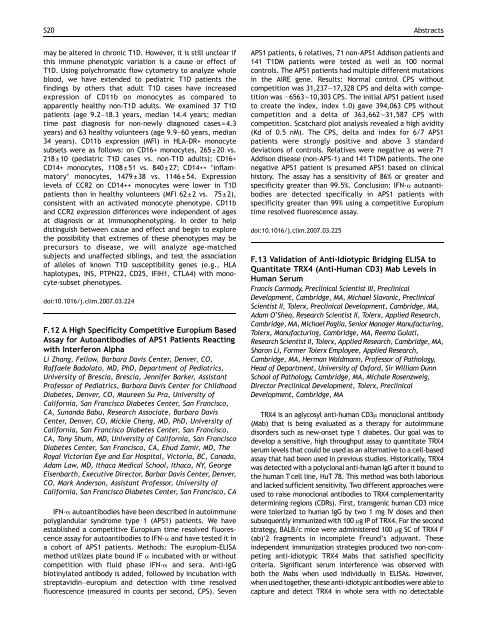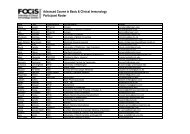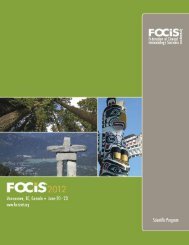Oral Presentations - Federation of Clinical Immunology Societies
Oral Presentations - Federation of Clinical Immunology Societies
Oral Presentations - Federation of Clinical Immunology Societies
You also want an ePaper? Increase the reach of your titles
YUMPU automatically turns print PDFs into web optimized ePapers that Google loves.
S20 Abstracts<br />
may be altered in chronic T1D. However, it is still unclear if<br />
this immune phenotypic variation is a cause or effect <strong>of</strong><br />
T1D. Using polychromatic flow cytometry to analyze whole<br />
blood, we have extended to pediatric T1D patients the<br />
findings by others that adult T1D cases have increased<br />
expression <strong>of</strong> CD11b on monocytes as compared to<br />
apparently healthy non-T1D adults. We examined 37 T1D<br />
patients (age 9.2–18.3 years, median 14.4 years; median<br />
time past diagnosis for non-newly diagnosed cases=4.3<br />
years) and 63 healthy volunteers (age 9.9–60 years, median<br />
34 years). CD11b expression (MFI) in HLA-DR+ monocyte<br />
subsets were as follows: on CD16+ monocytes, 265±20 vs.<br />
218±10 (pediatric T1D cases vs. non-T1D adults); CD16+<br />
CD14+ monocytes, 1108 ±51 vs. 840±27; CD14++ ‘inflammatory’<br />
monocytes, 1479±38 vs. 1146±54. Expression<br />
levels <strong>of</strong> CCR2 on CD14++ monocytes were lower in T1D<br />
patients than in healthy volunteers (MFI 62±2 vs. 75±2),<br />
consistent with an activated monocyte phenotype. CD11b<br />
and CCR2 expression differences were independent <strong>of</strong> ages<br />
at diagnosis or at immunophenotyping. In order to help<br />
distinguish between cause and effect and begin to explore<br />
the possibility that extremes <strong>of</strong> these phenotypes may be<br />
precursors to disease, we will analyze age-matched<br />
subjects and unaffected siblings, and test the association<br />
<strong>of</strong> alleles <strong>of</strong> known T1D susceptibility genes (e.g., HLA<br />
haplotypes, INS, PTPN22, CD25, IFIH1, CTLA4) with monocyte-subset<br />
phenotypes.<br />
doi:10.1016/j.clim.2007.03.224<br />
F.12 A High Specificity Competitive Europium Based<br />
Assay for Autoantibodies <strong>of</strong> APS1 Patients Reacting<br />
with Interferon Alpha<br />
Li Zhang, Fellow, Barbara Davis Center, Denver, CO,<br />
Raffaele Badolato, MD, PhD, Department <strong>of</strong> Pediatrics,<br />
University <strong>of</strong> Brescia, Brescia, Jennifer Barker, Assistant<br />
Pr<strong>of</strong>essor <strong>of</strong> Pediatrics, Barbara Davis Center for Childhood<br />
Diabetes, Denver, CO, Maureen Su Pra, University <strong>of</strong><br />
California, San Francisco Diabetes Center, San Francisco,<br />
CA, Sunanda Babu, Research Associate, Barbara Davis<br />
Center, Denver, CO, Mickie Cheng, MD, PhD, University <strong>of</strong><br />
California, San Francisco Diabetes Center, San Francisco,<br />
CA, Tony Shum, MD, University <strong>of</strong> California, San Francisco<br />
Diabetes Center, San Francisco, CA, Ehud Zamir, MD, The<br />
Royal Victorian Eye and Ear Hospital, Victoria, BC, Canada,<br />
Adam Law, MD, Ithaca Medical School, Ithaca, NY, George<br />
Eisenbarth, Executive Director, Barbar Davis Center, Denver,<br />
CO, Mark Anderson, Assistant Pr<strong>of</strong>essor, University <strong>of</strong><br />
California, San Francisco Diabetes Center, San Francisco, CA<br />
IFN-α autoantibodies have been described in autoimmune<br />
polyglandular syndrome type 1 (APS1) patients. We have<br />
established a competitive Europium time resolved fluorescence<br />
assay for autoantibodies to IFN-α and have tested it in<br />
a cohort <strong>of</strong> APS1 patients. Methods: The europium-ELISA<br />
method utilizes plate bound IF α incubated with or without<br />
competition with fluid phase IFN-α and sera. Anti-IgG<br />
biotinylated antibody is added, followed by incubation with<br />
streptavidin–europium and detection with time resolved<br />
fluorescence (measured in counts per second, CPS). Seven<br />
APS1 patients, 6 relatives, 71 non-APS1 Addison patients and<br />
141 T1DM patients were tested as well as 100 normal<br />
controls. The APS1 patients had multiple different mutations<br />
in the AIRE gene. Results: Normal control CPS without<br />
competition was 31,237∼17,328 CPS and delta with competition<br />
was −6563∼10,303 CPS. The initial APS1 patient (used<br />
to create the index, index 1.0) gave 394,063 CPS without<br />
competition and a delta <strong>of</strong> 363,662∼31,587 CPS with<br />
competition. Scatchard plot analysis revealed a high avidity<br />
(Kd <strong>of</strong> 0.5 nM). The CPS, delta and index for 6/7 APS1<br />
patients were strongly positive and above 3 standard<br />
deviations <strong>of</strong> controls. Relatives were negative as were 71<br />
Addison disease (non-APS-1) and 141 T1DM patients. The one<br />
negative APS1 patient is presumed APS1 based on clinical<br />
history. The assay has a sensitivity <strong>of</strong> 86% or greater and<br />
specificity greater than 99.5%. Conclusion: IFN-α autoantibodies<br />
are detected specifically in APS1 patients with<br />
specificity greater than 99% using a competitive Europium<br />
time resolved fluorescence assay.<br />
doi:10.1016/j.clim.2007.03.225<br />
F.13 Validation <strong>of</strong> Anti-Idiotypic Bridging ELISA to<br />
Quantitate TRX4 (Anti-Human CD3) Mab Levels in<br />
Human Serum<br />
Francis Carmody, Preclinical Scientist III, Preclinical<br />
Development, Cambridge, MA, Michael Slavonic, Preclinical<br />
Scientist II, Tolerx, Preclinical Development, Cambridge, MA,<br />
Adam O’Shea, Research Scientist II, Tolerx, Applied Research,<br />
Cambridge, MA, Michael Paglia, Senior Manager Manufacturing,<br />
Tolerx, Manufacturing, Cambridge, MA, Reema Gulati,<br />
Research Scientist II, Tolerx, Applied Research, Cambridge, MA,<br />
Sharon Li, Former Tolerx Employee, Applied Research,<br />
Cambridge, MA, Herman Waldmann, Pr<strong>of</strong>essor <strong>of</strong> Pathology,<br />
Head <strong>of</strong> Department, University <strong>of</strong> Oxford, Sir William Dunn<br />
School <strong>of</strong> Pathology, Cambridge, MA, Michale Rosenzweig,<br />
Director Preclinical Development, Tolerx, Preclinical<br />
Development, Cambridge, MA<br />
TRX4 is an aglycosyl anti-human CD3μ monoclonal antibody<br />
(Mab) that is being evaluated as a therapy for autoimmune<br />
disorders such as new-onset type 1 diabetes. Our goal was to<br />
develop a sensitive, high throughput assay to quantitate TRX4<br />
serum levels that could be used as an alternative to a cell-based<br />
assay that had been used in previous studies. Historically, TRX4<br />
was detected with a polyclonal anti-human IgG after it bound to<br />
the human T cell line, HuT 78. This method was both laborious<br />
and lacked sufficient sensitivity. Two different approaches were<br />
used to raise monoclonal antibodies to TRX4 complementarity<br />
determining regions (CDRs). First, transgenic human CD3 mice<br />
were tolerized to human IgG by two 1 mg IV doses and then<br />
subsequently immunized with 100 μg IP <strong>of</strong> TRX4. For the second<br />
strategy, BALB/c mice were administered 100 μg SC <strong>of</strong> TRX4 F<br />
(ab)′2 fragments in incomplete Freund’s adjuvant. These<br />
independent immunization strategies produced two non-competing<br />
anti-idiotypic TRX4 Mabs that satisfied specificity<br />
criteria. Significant serum interference was observed with<br />
both the Mabs when used individually in ELISAs. However,<br />
when used together, these anti-idiotypic antibodies were able to<br />
capture and detect TRX4 in whole sera with no detectable




